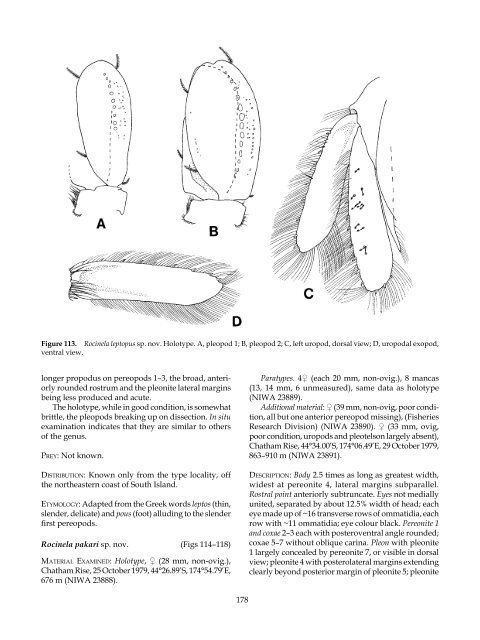The Marine Fauna of New Zealand: Isopoda, Aegidae (Crustacea)
The Marine Fauna of New Zealand: Isopoda, Aegidae (Crustacea)
The Marine Fauna of New Zealand: Isopoda, Aegidae (Crustacea)
Create successful ePaper yourself
Turn your PDF publications into a flip-book with our unique Google optimized e-Paper software.
Figure 113. Rocinela leptopus sp. nov. Holotype. A, pleopod ; B, pleopod 2; C, left uropod, dorsal view; D, uropodal exopod,<br />
ventral view.<br />
longer propodus on pereopods –3, the broad, anteriorly<br />
rounded rostrum and the pleonite lateral margins<br />
being less produced and acute.<br />
<strong>The</strong> holotype, while in good condition, is somewhat<br />
brittle, the pleopods breaking up on dissection. In situ<br />
examination indicates that they are similar to others<br />
<strong>of</strong> the genus.<br />
prey: Not known.<br />
distribution: Known only from the type locality, <strong>of</strong>f<br />
the northeastern coast <strong>of</strong> South Island.<br />
etymoLogy: Adapted from the Greek words leptos (thin,<br />
slender, delicate) and pous (foot) alluding to the slender<br />
first pereopods.<br />
Rocinela pakari sp. nov. (Figs 4– 8)<br />
materiaL examined: Holotype, ♀ (28 mm, non-ovig.),<br />
Chatham Rise, 25 October 979, 44°26.89’S, 74°54.79’E,<br />
676 m (NIWA 23888).<br />
78<br />
Paratypes. 4♀ (each 20 mm, non-ovig.), 8 mancas<br />
( 3, 4 mm, 6 unmeasured), same data as holotype<br />
(NIWA 23889).<br />
Additional material: ♀ (39 mm, non-ovig, poor condition,<br />
all but one anterior pereopod missing), (Fisheries<br />
Research Division) (NIWA 23890). ♀ (33 mm, ovig,<br />
poor condition, uropods and pleotelson largely absent),<br />
Chatham Rise, 44°34.00’S, 74°06.49’E, 29 October 979,<br />
863–9 0 m (NIWA 2389 ).<br />
desCription: Body 2.5 times as long as greatest width,<br />
widest at pereonite 4, lateral margins subparallel.<br />
Rostral point anteriorly subtruncate. Eyes not medially<br />
united, separated by about 2.5% width <strong>of</strong> head; each<br />
eye made up <strong>of</strong> ~ 6 transverse rows <strong>of</strong> ommatidia, each<br />
row with ~ ommatidia; eye colour black. Pereonite 1<br />
and coxae 2–3 each with posteroventral angle rounded;<br />
coxae 5–7 without oblique carina. Pleon with pleonite<br />
largely concealed by pereonite 7, or visible in dorsal<br />
view; pleonite 4 with posterolateral margins extending<br />
clearly beyond posterior margin <strong>of</strong> pleonite 5; pleonite

















